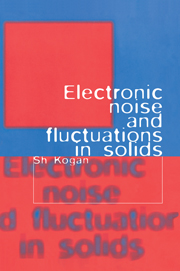Book contents
- Frontmatter
- Contents
- Preface
- Abbreviations
- 1 Introduction: Some basic concepts of the theory of random processes
- 2 Fluctuation–dissipation relations
- 3 Fluctuations in nonequilibrium gases
- 4 Generation–recombination noise
- 5 Noise in quantum ballistic systems
- 6 Resistance noise in metals
- 7 Noise in strongly disordered conductors
- 8 1/f noise and random telegraph noise
- 9 Noise in superconductors
- References
- Subject index
5 - Noise in quantum ballistic systems
Published online by Cambridge University Press: 17 March 2010
- Frontmatter
- Contents
- Preface
- Abbreviations
- 1 Introduction: Some basic concepts of the theory of random processes
- 2 Fluctuation–dissipation relations
- 3 Fluctuations in nonequilibrium gases
- 4 Generation–recombination noise
- 5 Noise in quantum ballistic systems
- 6 Resistance noise in metals
- 7 Noise in strongly disordered conductors
- 8 1/f noise and random telegraph noise
- 9 Noise in superconductors
- References
- Subject index
Summary
Introduction
In a ballistic conductor the charge carriers are moving between the electrodes without being scattered at impurities or phonons. Obviously, the length of the conductor has to be smaller than the free path length of the charge carriers, hence it has to be smaller than, say, 1 b.mum. Before the 1980s the only real solid state ballistic conductors were some very pure monocrystalline metals at liquid helium temperatures and microcontacts (microbridges) between bulk metals (Fig. 5.1). The latter were used in point contact spectroscopy of metals (Yanson, 1974). The resistance of the entire point contact is determined by the transverse dimensions and length of the narrow part (constriction). The conduction is ballistic if these dimensions are smaller than the electrons' freepath length. Since in metals the de-Broglie wavelength of electrons at the Fermi surface, λF, is of the order of interatomic distances, the microcontact's dimensions are inevitably many times greater than λF, and the ballistic motion of electrons in such microcontacts is always quasi-classical.
The recent progress in semiconductor technology made it possible to fabricate ballistic devices, the dimensions of which are of the same order as the wavelength of the charge carriers. These devices are called quantum ballistic systems, or quantum point contacts. They are made by giving a definite shape to the two-dimensional electron gas (2DEG).
The electrons in a 2DEG are confined to a two-dimensional quantum well. For instance, in a semiconductor heterostructure GaAlAs-GaAs-GaAlAs electrons in the GaAs layer are confined between two GaAlAs layers which serve as barriers.
- Type
- Chapter
- Information
- Electronic Noise and Fluctuations in Solids , pp. 130 - 166Publisher: Cambridge University PressPrint publication year: 1996

